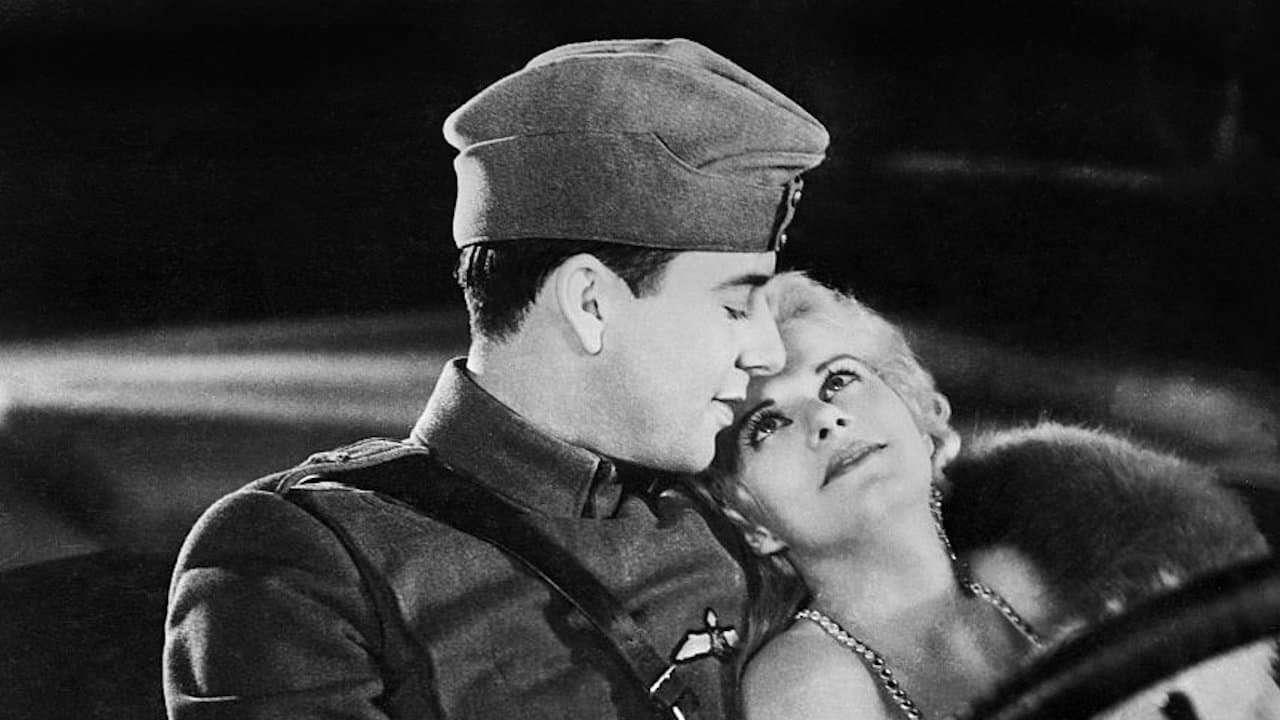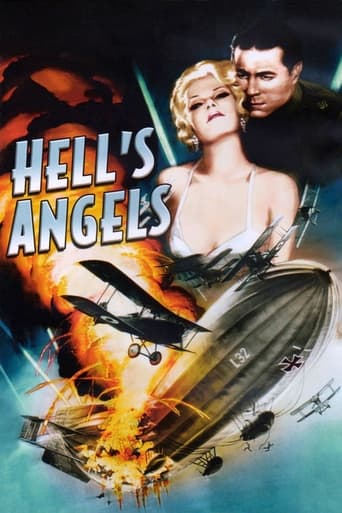

This is truly an historical film which not only contains the only color footage of Jean Harlow in a movie, and helped make her a star ("would you be shocked if I put on something more comfortable?"), but some of the best WW I airplane aerial sequences ever put on the screen (it was nominated for a Cinematography Oscar). Of course, this is due to the fact that aviator gazillionaire Howard Hughes produced, directed, and even filmed part of it. In fact, this film was initially going to be a silent with Greta Nissen in the Harlow role. But, during the time it was being made, the transformation from silent films to "talkies" was taking place. So, having more money than God, Hughes decided to reshoot most of it, requiring that he replace the Norwegian actress with Harlow.The story begins with three Oxford classmates, brothers Monte (Ben Lyon) and Roy (James Hall) Rutledge and their German friend Karl Armstedt (John Darrow), sharing a flat in pre-war Germany and fully enjoying the perks. Roy has a girl, Helen (Harlow), back home who he's constantly referring to, while Monte plays the field to excess. In fact, he's even gotten mixed up with a Baroness (Jane Winton), the wife of a German officer Baron Von Kranz (Lucien Prival, a recognizable character actor). When the Baron returns home prematurely, he catches Monte with his wife and challenges him to a duel. Since Monte is a man of little character, he flees back home to school at Oxford. His noble brother, Roy, pretends to be Monte, accepting the challenge to protect his name from disgrace. Though he is wounded, he returns to school and never mentions it to his brother.War breaks out and classmate Karl is summoned to return to Germany to serve. Roy enlists, but of course Monte does not. However, while wanting to kiss the pretty girl at a recruitment station, he accidentally signs up too. Before they go off to war, Roy wants to introduce his brother to his girl, whom Monte assumes must be a "dog". When they meet, both are pleasantly surprised (with Harlow winning the "look 'em over" staring contest;-) and we learn that Helen isn't as faithful to Roy as he thinks she is. This leads to a first "date" affair (and Harlow's signature line, above) but when Roy regrets his infidelity, perhaps for the first time in his life, it causes a rift between the two illicit lovers before he and his brother head off to war.One spectacular visual sequence involves Karl as the bombardier on a German Zeppelin that infiltrates London. Unbeknownst to the ship's commander, he guides it through the fog in order to drop its bombs harmlessly into a lake on the outskirts of the city. Alerted to the Zeppelin's presence, the Allies send several planes to intercept it and the chase is on. When the ship's commander needs more height to avoid their pursuit, and after throwing all non-essential equipment overboard doesn't work, he has the bombardier's pod's cable cut, dropping Karl to his death. He then orders all unnecessary personnel to jump overboard. The commander's ruthlessness almost succeeds, as his gunners shoot down all but one of the planes. However, the last plane utilizes a kamikaze maneuver, sacrificing himself and plane into the heart of the "big balloon".Roy and Monte are both trained as pilots and must fly nightly patrols. Since nearly every night means the end of at least one of the pilots, Monte does his best to avoid the duty. However, when Roy finally learns Helen doesn't love him (serving as a waitress on the war front, he catches her with a ranking officer) and signs up for a risky mission of great importance, his brother's bravery convinces Monte to also volunteer for the effort.The film's most spectacular visual scenes follow and dominate the rest of the film, but there is also a rather clever plot device used to end the drama between the brothers and involving Von Kranz.
... View More"Hell's Angels" probably still boasts the most impressive aerial fight scenes in film. I've never seen anything like them. It was no great surprise to me that four people were killed during the making of the movie. Much of what you see seems incredibly dangerous. I'm not talking about the scenes where the planes are actually shot down or destroyed. Who could forget, for example, the scene where the plane crashes into the zeppelin? I assume that when the planes crashed or were blown up, no one was in any real danger. What is truly hair raising are the shots of planes whirling around and flying tightly like a swarm of insects. You expect an unscripted mid air collision.Aside from that, the movie is good, not great. I was not surprised that Jean Harlow was the only performer I recognised. The two actors who play the brothers are both pretty unimpressive. They serve the plot well enough, but it is plain to see that Howard Hughes had an eye for planes, not people.
... View MoreI'm glad that my fondness for Jean Harlow led me to see this amazing film. So many scenes haunt me from this film, especially the pilots, the night before a crucial bombing run, talking about the futility of worrying about whether or not they were going to die... they probably were... and the man who was accused of being "yellow" because he dared question why they were Over There to begin with .... the Germans taking orders from their commanding officer in the zeppelin (I won't tell you what they are so as not to place spoilers in my review). The plane crashes in the hillsides were real planes and they were really crashing. The score was great as well. One of the great war epics.
... View More. . . who proves to be a Brit! The power of life to imitate art cannot be overestimated, and Howard Hughes was a master of insinuating his morbid fantasies into the fabric of civilization forevermore. He famously designed the cantilevered brassiere for one of his movies, which persisted to Madonna and beyond. Here, in the oddly-titled HELL'S ANGELS, the Allied anti-heroes use suicide as a military tactic more than once. Not to be outdone, dozens of Germans march out the bomb bay of their dirigible without parachutes, viewing themselves as expendable ballast. Even fratricide is not off limits to the main character, and if Howard could have worked a little incest into the plot I'm sure he would have. Hughes lured three stunt pilots to their deaths in "real life" during the making of this flick. It got to the point where Howard had to put his mouth where his money was, and fly his death crates himself for the stunts toward the end of the shoot. As a death-obsessed crazy living a charmed life, he survived to film this movie not once, but twice, making it the most expensive flick until GONE WITH THE WIND came out. Adjusted for ego and inflation, it tops HEAVEN'S GATE and ISHTAR put together as a monument to the wrong-headed promulgation of dangerous ideas which obviously inspired PEARL HARBOR. Too bad we do not know what variation of "Rosebud" Hughes was muttering as he passed away in his museum of his own carefully bottled and preserved urine.
... View More